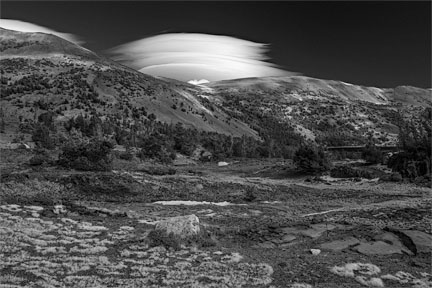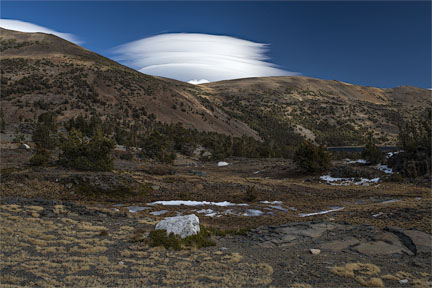Reader Comments: Lenticular Clouds Shot with Nikon D850, Zeiss Milvus 35mm f/1.4

Saddlebag Lake East Mountains
(larger color version further below)
Get Zeiss Milvus for Nikon or Canon and Nikon D850 at B&H Photo.
James A writes:
Great photo of the lenticular clouds over Saddlebag Lake.
I thought that the “lenticular” subject matter was very apropos.
DIGLLOYD: the Nikon D850 performed like a champ; this is/was a very high contrast scene that used the entire dynamic range of the sensor and is a perfect ETTR exposure. To preserve detail in the clouds meant a very dark foreground, pushed up in brightness during raw conversion.
The Zeiss Milvus 35mm f/1.4 used for this shot is superb (see First Look at the Zeiss Milvus 35mm f/1.4), just about Otus grade by f/2.8. It 'sings' on the D850 as do the Milvus 18/2.8 and Milvus 25/1.4, which three together have now become my go-to landscape set (Otus 55 or another lens sometimes). Never have I had a trio of wides even approaching this quality. They go into the pack by habit now, barring other priorities.
I had at most minutes to make the shot, and indeed the 3rd shot for the stack did not have the right shape and definition of the first shot for the rising clouds and even the 2nd was not quite as good.

Times off by one hour and should be 13:01; D850 not adjusted for daylight savings time.
More commentary follows.
Image can be viewed in color and black and white at up to 8K 45 megapixels on the Zeiss Milvus 35mm f/1.4 Examples: Eastern Sierra, Late Season. Toggle for black and white version.

NIKON D850 + Zeiss Milvus 35mm f/1.4
[low-res image for bot]
Dr S writes:
Beautiful image of the lenticular clouds over Saddlebag. I've never seen such clarity and accuracy than what you've posted.
Once the D850 is looked at and repaired it is a winner.
DIGLLOYD: as for the Nikon D850, excepting the flange focal distance issue, I consider it the best DSLR ever made (Canon is now a full pay grade lower and looking positively aged), and the D850 color rendition to my eyes is the best of any camera on the market, excluding medium format.
The Fujifilm GFX still gets the nod for total image quality or so I estimate at this point (TBD fairly soon), but the latest Zeiss Milvus wide angle lenses are really Otus-grade lenses in most respects and thus offer huge appeal, having far superior build quality and often with two stops more lens speed. IMO these are the two best camera systems on the market today (excluding klunky hyper expensive medium format rigs), offering huge value for what they deliver. I vastly prefer shooting the D850 in the field over the Sony A7R II, and the A7R III is not likely to change that. Particularly in cold weather where gloves are needed the Sony cameras are a disaster, and even the D850 screwed up one thing, a too-small 4-way controller. Carry weight is another matter. Sony pixel shift would have been largely useless for weeks this fall given wind, but it does have potential, which might force me into carrying both at times (with Zeiss Loxia).
The “clarity and accuracy” comes from the jaw-dropping power of focus stacking, which when properly executed (shooting and the stacking which follows), is the only way to achieve this kind of clarity. I eagerly await the emergence of 8K displays so that I can see 33 megapixels at once, even if that does not allow the full 45 megapixel D850 image to be viewed in its entirety. But an iMac 5K is stunning already.
I deem focus stacking a mandatory skill for any photographer. A “‘getting started” article on focus stacking will appear on lenspire.Zeiss.com soon. Those looking to greatly accelerate the learning process might consider one of my one-on-one photo tours.
- The Significance of Automated Focus Stepping for Focus Stacking (Nikon D850)
- Nikon D850: 'Focus Shift Shooting' Feature is a Reason by Itself to buy the Nikon D850 — Saves Time, Guarantees Peak Quality
- My focus stacking section in Making Sharp Images, which I will be expanding.
This is one of those images where seconds counted. I shot the distance image within 30 seconds (using a tripod, composing, then focusing manually in magnified Live View). I needed the tripod so I could focus stack for a razor-sharp foreground and middle-ground, and indeed it is razor sharp to 45 megapixels. Using f/11 could not have achieved the same visual impact; focus stacking of this kind is “hyper real” at 45 megapixels since the eye cannot take in the detail in this kind of scene whereas a taken image allows time to explore.
There are many details included; I try hard to do this in my landscape images so that they contain far more subtlety than a viewer might realize, but someone who knows the area and its variability might appreciate. In this sense, I will state that I prefer many of my images to “better” showy images that grab the eye but contain little subtlety (for example, Apple’s chose beautiful macOS High Sierra image).
It captures by intention far more than it might appear at a glance: overall landscape of course, transition zones of flora, the damage caused to the trees by the harsh winter of 2016/2017, the lucky almost snow-free playground conditions in mid-November, the type of clouds themselves (rare these past years in my visits), the mixed geological character with gneiss glacial erratics among metamorphic bedrock etched by glacial activity, just enough sense of place (Saddlebag Lake) to make it more meaningful over time, the dappled lighting so typical of the High Sierra when clouds form, including the implicit movement of light across the hills, the lingering snow in shaded areas from a snowstorm that shows a subsequent unseasonal warmth, but also the typical hard freezes at night creating the solid-ice pools. However, I was disappointed not to have a pika perch on the foreground or background gneiss boulder, or some bighorn sheep on the far ridge!






























